Monsoon Season 2020: Another Non-soon
Special Stories
30 Sep 2020 2:23 PM
As the monsoon season wraps up in the Southwestern United States, residents of the region may have noticed a significant lack of rainfall compared to past seasons. In fact, the monsoon season in 2019 also underperformed, but 2020 was even more exceptional....and not in a good way.
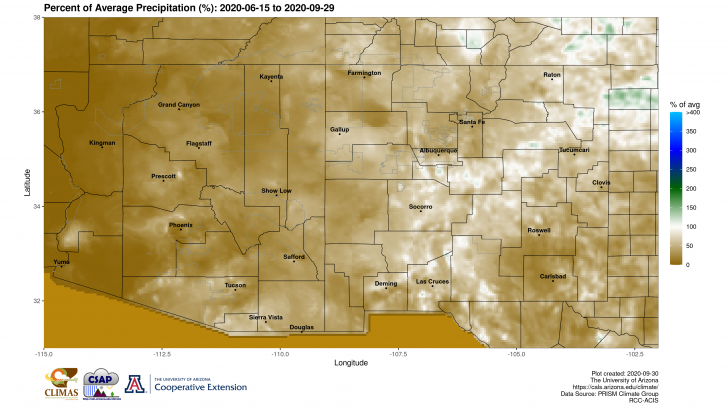 IMAGE COURTESY OF THE UNIVERSITY OF ARIZONA (CLICK FOR LARGER IMAGE)
Monsoon season officially runs from June 15 through September 30 each year, nearly coinciding with the summer season. It is characterized by a shift in the prevailing wind direction.
IMAGE COURTESY OF THE UNIVERSITY OF ARIZONA (CLICK FOR LARGER IMAGE)
Monsoon season officially runs from June 15 through September 30 each year, nearly coinciding with the summer season. It is characterized by a shift in the prevailing wind direction.
 Due to the intense heat from the summer sun, a thermal low pressure develops over the Desert Southwest. At the same time, an area of high pressure develops in the upper atmosphere over the Four Corners area. The wind flow around these features directs tropical moisture from the Gulf of California (Pacific Ocean basin) and the Gulf of Mexico (Atlantic Ocean basin) into the region. This moisture often translates into gusty thunderstorms, bringing the bulk of the region's yearly rainfall.
In 2020, however, the pattern was present but not overly persistent or productive. There were times when some areas picked up beneficial rainfall, but not too often.
https://twitter.com/WeatherNation/status/1286617127072305152
Unfortunately---and in Arizona especially---most of the season remained lackluster and dry. The cities of Phoenix, Tucson, and Flagstaff all reported some of their driest monsoon seasons on record. In the case of Flagstaff, it was their driest season since records began in 1898.
Due to the intense heat from the summer sun, a thermal low pressure develops over the Desert Southwest. At the same time, an area of high pressure develops in the upper atmosphere over the Four Corners area. The wind flow around these features directs tropical moisture from the Gulf of California (Pacific Ocean basin) and the Gulf of Mexico (Atlantic Ocean basin) into the region. This moisture often translates into gusty thunderstorms, bringing the bulk of the region's yearly rainfall.
In 2020, however, the pattern was present but not overly persistent or productive. There were times when some areas picked up beneficial rainfall, but not too often.
https://twitter.com/WeatherNation/status/1286617127072305152
Unfortunately---and in Arizona especially---most of the season remained lackluster and dry. The cities of Phoenix, Tucson, and Flagstaff all reported some of their driest monsoon seasons on record. In the case of Flagstaff, it was their driest season since records began in 1898.
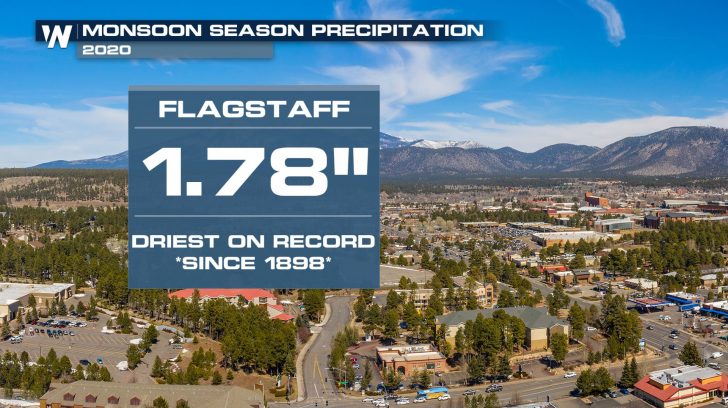
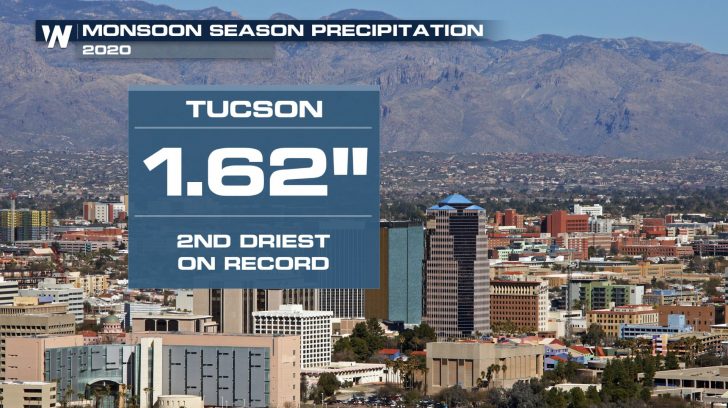
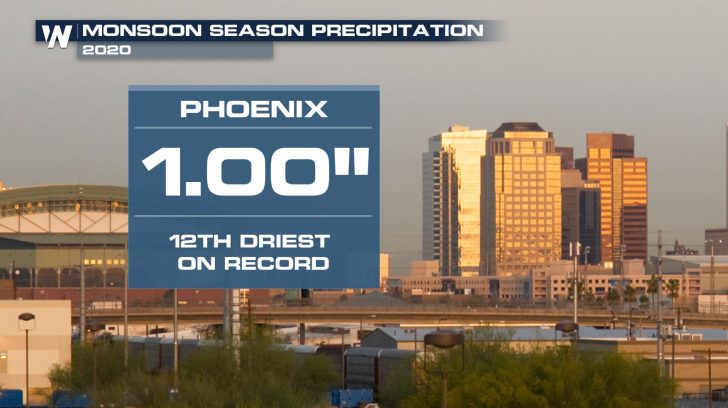 Perhaps most eye-opening was what happened in Yuma, Arizona. That city did not pick up any rain during the 2020 monsoon season! This was the first time that happened since records began in 1876. Normal or average rainfall in Yuma between June and September is 1.30 inches.
Perhaps most eye-opening was what happened in Yuma, Arizona. That city did not pick up any rain during the 2020 monsoon season! This was the first time that happened since records began in 1876. Normal or average rainfall in Yuma between June and September is 1.30 inches.
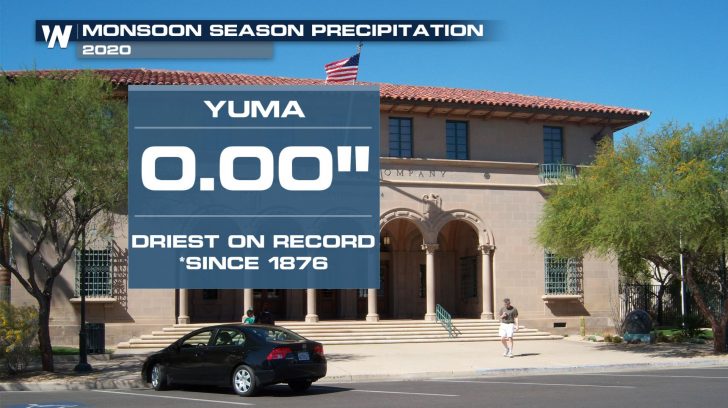 In neighboring New Mexico, some areas---especially with mountainous terrain---did receive a normal amount of rainfall for the season. This was certainly good news for the Land of Enchantment, where many locations in the south central and northeastern parts of the state receieved between 4 and 12 inches of rainfall.
In neighboring New Mexico, some areas---especially with mountainous terrain---did receive a normal amount of rainfall for the season. This was certainly good news for the Land of Enchantment, where many locations in the south central and northeastern parts of the state receieved between 4 and 12 inches of rainfall.
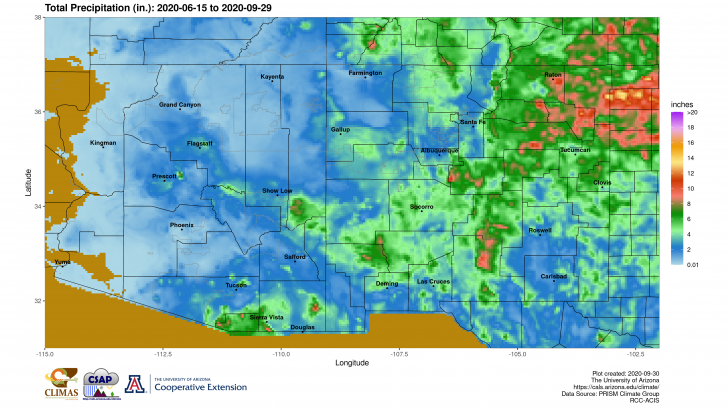 IMAGE COURTESY OF THE UNIVERSITY OF ARIZONA (CLICK FOR LARGER IMAGE)
Generally speaking, a monsoon season that lacks significant rainfall can derail an entire year in an area that is moisture-starved to begin with. It is no surprise that major drought concerns are ongoing in the Southwest. Drought brings many concerns: increased wildfire danger, reduced water supply for cities, and threats to crop production.
IMAGE COURTESY OF THE UNIVERSITY OF ARIZONA (CLICK FOR LARGER IMAGE)
Generally speaking, a monsoon season that lacks significant rainfall can derail an entire year in an area that is moisture-starved to begin with. It is no surprise that major drought concerns are ongoing in the Southwest. Drought brings many concerns: increased wildfire danger, reduced water supply for cities, and threats to crop production.
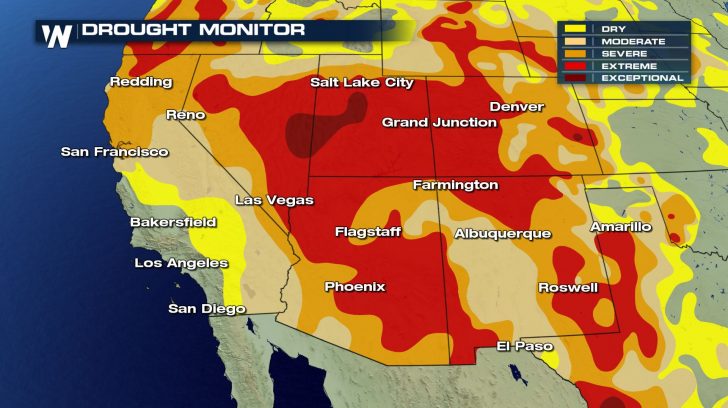 Even though monsoon season brings the majority of annual rainfall to the Southwest, the fall and winter seasons can still provide much-needed moisture. After a disappointing 2020 monsoon season, hopefully conditions will improve. For an update on the Fall outlook from the Climate Prediction Center, click HERE. Join WeatherNation in the months ahead as we bring you the latest forecast information for the Southwest and from coast to coast.
For more meteorological and climatological data about the Southwest Monsoon, head to the University of Arizona's informative website.
Even though monsoon season brings the majority of annual rainfall to the Southwest, the fall and winter seasons can still provide much-needed moisture. After a disappointing 2020 monsoon season, hopefully conditions will improve. For an update on the Fall outlook from the Climate Prediction Center, click HERE. Join WeatherNation in the months ahead as we bring you the latest forecast information for the Southwest and from coast to coast.
For more meteorological and climatological data about the Southwest Monsoon, head to the University of Arizona's informative website.
 IMAGE COURTESY OF THE UNIVERSITY OF ARIZONA (CLICK FOR LARGER IMAGE)
Monsoon season officially runs from June 15 through September 30 each year, nearly coinciding with the summer season. It is characterized by a shift in the prevailing wind direction.
IMAGE COURTESY OF THE UNIVERSITY OF ARIZONA (CLICK FOR LARGER IMAGE)
Monsoon season officially runs from June 15 through September 30 each year, nearly coinciding with the summer season. It is characterized by a shift in the prevailing wind direction.
 Due to the intense heat from the summer sun, a thermal low pressure develops over the Desert Southwest. At the same time, an area of high pressure develops in the upper atmosphere over the Four Corners area. The wind flow around these features directs tropical moisture from the Gulf of California (Pacific Ocean basin) and the Gulf of Mexico (Atlantic Ocean basin) into the region. This moisture often translates into gusty thunderstorms, bringing the bulk of the region's yearly rainfall.
In 2020, however, the pattern was present but not overly persistent or productive. There were times when some areas picked up beneficial rainfall, but not too often.
https://twitter.com/WeatherNation/status/1286617127072305152
Unfortunately---and in Arizona especially---most of the season remained lackluster and dry. The cities of Phoenix, Tucson, and Flagstaff all reported some of their driest monsoon seasons on record. In the case of Flagstaff, it was their driest season since records began in 1898.
Due to the intense heat from the summer sun, a thermal low pressure develops over the Desert Southwest. At the same time, an area of high pressure develops in the upper atmosphere over the Four Corners area. The wind flow around these features directs tropical moisture from the Gulf of California (Pacific Ocean basin) and the Gulf of Mexico (Atlantic Ocean basin) into the region. This moisture often translates into gusty thunderstorms, bringing the bulk of the region's yearly rainfall.
In 2020, however, the pattern was present but not overly persistent or productive. There were times when some areas picked up beneficial rainfall, but not too often.
https://twitter.com/WeatherNation/status/1286617127072305152
Unfortunately---and in Arizona especially---most of the season remained lackluster and dry. The cities of Phoenix, Tucson, and Flagstaff all reported some of their driest monsoon seasons on record. In the case of Flagstaff, it was their driest season since records began in 1898.


 Perhaps most eye-opening was what happened in Yuma, Arizona. That city did not pick up any rain during the 2020 monsoon season! This was the first time that happened since records began in 1876. Normal or average rainfall in Yuma between June and September is 1.30 inches.
Perhaps most eye-opening was what happened in Yuma, Arizona. That city did not pick up any rain during the 2020 monsoon season! This was the first time that happened since records began in 1876. Normal or average rainfall in Yuma between June and September is 1.30 inches.
 In neighboring New Mexico, some areas---especially with mountainous terrain---did receive a normal amount of rainfall for the season. This was certainly good news for the Land of Enchantment, where many locations in the south central and northeastern parts of the state receieved between 4 and 12 inches of rainfall.
In neighboring New Mexico, some areas---especially with mountainous terrain---did receive a normal amount of rainfall for the season. This was certainly good news for the Land of Enchantment, where many locations in the south central and northeastern parts of the state receieved between 4 and 12 inches of rainfall.
 IMAGE COURTESY OF THE UNIVERSITY OF ARIZONA (CLICK FOR LARGER IMAGE)
Generally speaking, a monsoon season that lacks significant rainfall can derail an entire year in an area that is moisture-starved to begin with. It is no surprise that major drought concerns are ongoing in the Southwest. Drought brings many concerns: increased wildfire danger, reduced water supply for cities, and threats to crop production.
IMAGE COURTESY OF THE UNIVERSITY OF ARIZONA (CLICK FOR LARGER IMAGE)
Generally speaking, a monsoon season that lacks significant rainfall can derail an entire year in an area that is moisture-starved to begin with. It is no surprise that major drought concerns are ongoing in the Southwest. Drought brings many concerns: increased wildfire danger, reduced water supply for cities, and threats to crop production.
 Even though monsoon season brings the majority of annual rainfall to the Southwest, the fall and winter seasons can still provide much-needed moisture. After a disappointing 2020 monsoon season, hopefully conditions will improve. For an update on the Fall outlook from the Climate Prediction Center, click HERE. Join WeatherNation in the months ahead as we bring you the latest forecast information for the Southwest and from coast to coast.
For more meteorological and climatological data about the Southwest Monsoon, head to the University of Arizona's informative website.
Even though monsoon season brings the majority of annual rainfall to the Southwest, the fall and winter seasons can still provide much-needed moisture. After a disappointing 2020 monsoon season, hopefully conditions will improve. For an update on the Fall outlook from the Climate Prediction Center, click HERE. Join WeatherNation in the months ahead as we bring you the latest forecast information for the Southwest and from coast to coast.
For more meteorological and climatological data about the Southwest Monsoon, head to the University of Arizona's informative website.All Weather News
More